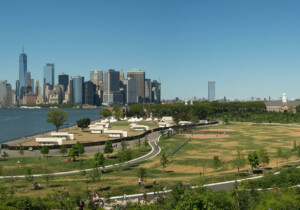At the National Design Awards Ceremony at the White House on September 20, Michelle Obama confessed that Barack really wanted to be an architect—but he wasn’t talented enough. This was recounted by Henk Ovink, senior advisor to HUD Secretary Shaun Donovan, at the 4th Municipal Art Society (MAS) Summit, held October 17-18 in New York City. During the event, the themes of Innovation and Leadership heralded the upcoming New York mayoral election and the one-year anniversary of Hurricane Sandy.
The Summit is a testing ground for MAS’s current and future work, and there couldn’t be a clearer indication that this institution has moved beyond the shadow of its most historic achievement—the saving of Grand Central Terminal—decades ago. MAS’s commitment to New York as a livable, globally-competitive city that is socially, economically, and environmentally resilient—note that last watchword—is a hallmark of President Vin Cipolla’s leadership. In more than 40 sessions over 2 days, here are some of the highlights of the Summit.
Talks by foundation presidents Judith Rodin (Rockefeller), Darren Walker (Ford), Rip Rapson (Kresge), and Stephen Huddard (McConnell) allowed us to hear priorities straight from the top of the funding chain. Rodin spoke about the Rockefeller’s recently announced “100 Resilient Cities” initiative whose winners will receive technical support for urban resilience over three years—there’s that word “resilience” again—while Walker, in his first public outing as president, talked about the difference between equity and equality in the Just City. Rapson noted that Detroit was dealing with vacant land the size of San Francisco, and Hubbard highlighted the innovative SVX social financing scheme in Canada, and sticking to theme, lauded a conference called “Art of Resilience, the Resilience of Art.”
The dilemma about what to do with the problematic Penn Station: possibilities, financial options, and locating Madison Square Garden were discussed and debated. Panels were enhanced by presentations by four architecture firms invited by MAS to imagine a new station complex: H3, DS+R, SOM, and SHoP.
A heavy-hitter real estate panel representing such firms as Hines, JDS, and Brookfield (noticeably, this men’s panel followed a female panel “Redefining Social and Economic Value in the Age of Sharing” featuring Etsy, Airbnb, Mesh Labs) was contrasted with Brandon Jenkins’s Popularise, a bottom-up real estate model launched at the vibrant H St. NE in Washington, DC.
In “New Ideas for the Next Administration,” Carol Coletta (Knight Foundation, formerly ArtPlace) posed questions to panelists who were each magically were transformed into the next NYC mayor. One of the new leaders proposed NYC-only visas for teachers and professionals. Another new mayor, Eddie Torres of the Rockefeller Foundation reminded us that NYCHA would be the 11th largest city in the country (in a separate presentation, NYCHA talked about plans to develop it’s “vacant” property, i.e. parking lots and green spaces into public and private housing. And speaking of public housing, Richard Sennett referred to growing up in Chicago’s notorious and now demolished Cabrini Green).
The rousing Richard Saul Wurman (TED founder, Access guides) presented his latest project, the cartographic cloud-based “Urban Observatory.” It allows direct visual comparison of cities, using the common language of data ranging from climate, age distribution, air quality, traffic, crime statistics, electricity and more, that can be an enormously useful tool for urban planners as well as inhabitants.
Shohei Shigematus of OMA showed the firm’s provocative redefinition of mixed-use high rises which he says have become a generic “Bento-box” assortment of functions. They’ve posed alternatives in Sao Paolo, Santa Monica, and Miami Beach.
And for ingenuity, how MAS’s Mary Rowe’s citation of Occupy Sandy’s use of Amazon’s wedding registry to get Hurricane Sandy victims the goods they actually need.










